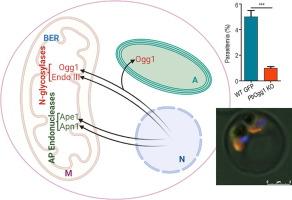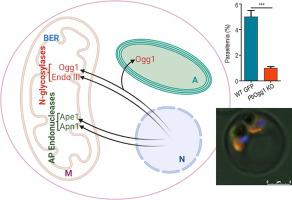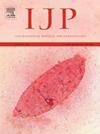DNA N-glycosylases Ogg1 and EndoIII as components of base excision repair in Plasmodium falciparum organelles
IF 3.7
2区 医学
Q1 PARASITOLOGY
引用次数: 0
Abstract
The integrity of genomes of the two crucial organelles of the malaria parasite — an apicoplast and mitochondrion in each cell − must be maintained by DNA repair mediated by proteins targeted to these compartments. We explored the localisation and function of Plasmodium falciparum base excision repair (BER) DNA N-glycosylase homologs PfEndoIII and PfOgg1. These N-glycosylases would putatively recognise DNA lesions prior to the action of apurinic/apyrimidinic (AP)-endonucleases. Both Ape1 and Apn1 endonucleases have earlier been shown to function solely in the parasite mitochondrion. Immunofluorescence localisation showed that PfEndoIII was exclusively mitochondrial. PfOgg1 was not seen clearly in mitochondria when expressed as a PfOgg1leader-GFP fusion, although chromatin immunoprecipitation assays showed that it could interact with both mitochondrial and apicoplast DNA. Recombinant PfEndoIII functioned as a DNA N-glycosylase as well as an AP-lyase on thymine glycol (Tg) lesions. We further studied the importance of Ogg1 in the malaria life cycle using reverse genetic approaches in Plasmodium berghei. Targeted disruption of PbOgg1 resulted in loss of 8-oxo-G specific DNA glycosylase/lyase activity. PbOgg1 knockout did not affect blood, mosquito or liver stage development but caused reduced blood stage infection after inoculation of sporozoites in mice. A significant reduction in erythrocyte infectivity by PbOgg1 knockout hepatic merozoites was also observed, thus showing that PbOgg1 ensures smooth transition from liver to blood stage infection. Our results strengthen the view that the Plasmodium mitochondrial genome is an important site for DNA repair by the BER pathway.


DNA N-糖基化酶 Ogg1 和 EndoIII 是恶性疟原虫细胞器中碱基切除修复的组成部分。
疟原虫的两个关键细胞器--每个细胞中的顶体和线粒体--的基因组的完整性必须通过这些细胞器的靶向蛋白介导的 DNA 修复来维持。我们研究了恶性疟原虫碱基切除修复(BER)DNA N-糖基化酶同源物 PfEndoIII 和 PfOgg1 的定位和功能。这些 N-糖基化酶可能会在嘌呤/近嘧啶(AP)内切酶发挥作用之前识别 DNA 病变。Ape1 和 Apn1 内切酶早先都被证明只在寄生虫线粒体中发挥作用。免疫荧光定位显示,PfEndoIII 只存在于线粒体中。PfOgg1 以 PfOgg1leader-GFP 融合体的形式表达时,线粒体中看不到明显的 PfOgg1,但染色质免疫沉淀测定显示,PfOgg1 可与线粒体和 apicoplast DNA 相互作用。重组 PfEndoIII 可作为 DNA N-糖基化酶以及胸腺嘧啶乙二醇(Tg)病变的 AP-裂解酶发挥作用。我们利用反向遗传方法进一步研究了 Ogg1 在伯格氏疟原虫疟疾生命周期中的重要性。PbOgg1的靶向破坏导致8-氧代-G特异性DNA糖基化酶/裂解酶活性的丧失。PbOgg1 基因敲除不会影响血液、蚊子或肝脏阶段的发育,但会降低小鼠接种孢子虫后血液阶段的感染率。此外,还观察到 PbOgg1 基因敲除肝脏裂殖子对红细胞的感染率明显降低,从而表明 PbOgg1 确保了从肝脏感染到血液感染阶段的顺利过渡。我们的研究结果进一步证实,疟原虫线粒体基因组是通过 BER 途径进行 DNA 修复的重要场所。
本文章由计算机程序翻译,如有差异,请以英文原文为准。
求助全文
约1分钟内获得全文
求助全文
来源期刊
CiteScore
8.40
自引率
2.50%
发文量
76
审稿时长
23 days
期刊介绍:
International Journal for Parasitology offers authors the option to sponsor nonsubscriber access to their articles on Elsevier electronic publishing platforms. For more information please view our Sponsored Articles page. The International Journal for Parasitology publishes the results of original research in all aspects of basic and applied parasitology, including all the fields covered by its Specialist Editors, and ranging from parasites and host-parasite relationships of intrinsic biological interest to those of social and economic importance in human and veterinary medicine and agriculture.

 求助内容:
求助内容: 应助结果提醒方式:
应助结果提醒方式:


